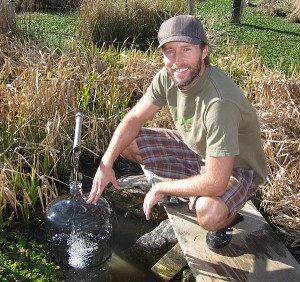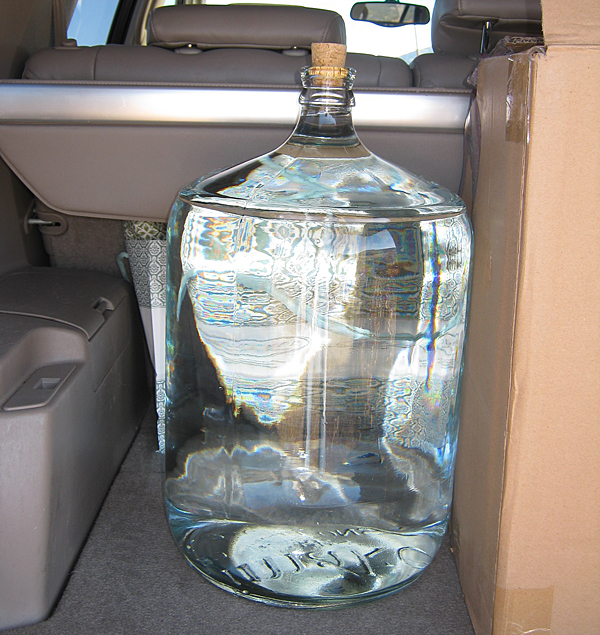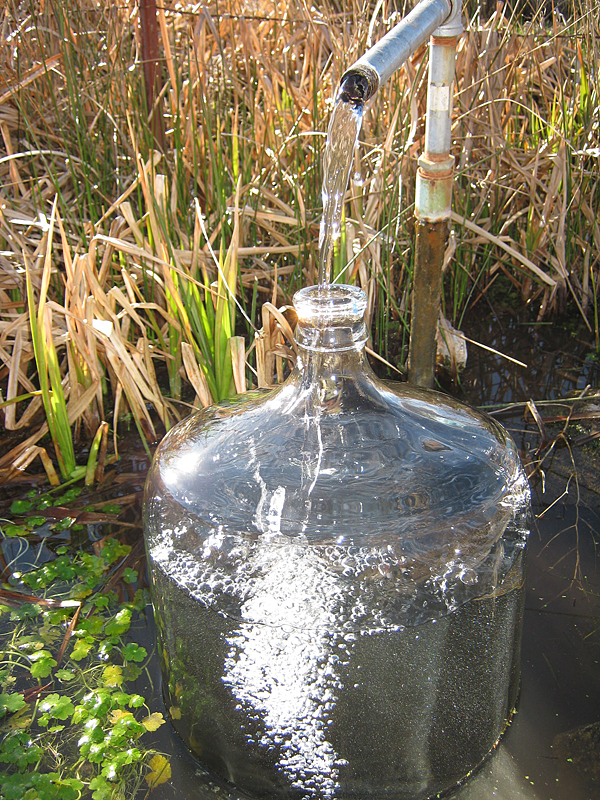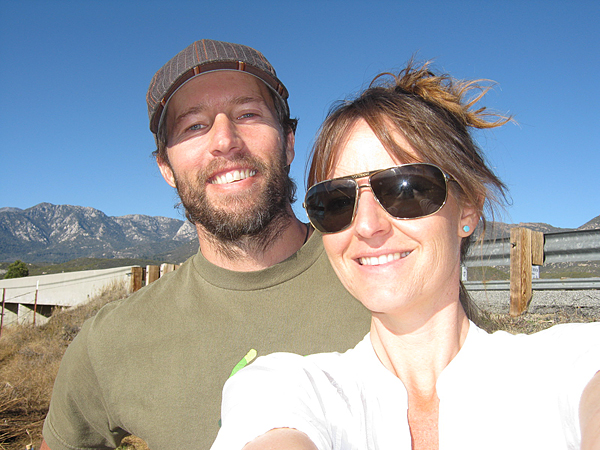| Click play below to hear our lively interview with spring water expert David Wolfe. |
| Listen to other shows about this topic. |
|
 As many of you know lately we’ve been more interested in drinking higher quality water.
As many of you know lately we’ve been more interested in drinking higher quality water.
We recently watched the documentary called Tapped which I’ll share more about below.
which I’ll share more about below.
That was the straw the broke the camels back in terms of kicking us in the pants to stop drinking plastic tea from water bottles.
I’ve been learning about structured and vortexed spring water for years but needed something to get our butt in gear to actually make the transition. I hope this post will help you determine what accessories you need to get started and how to actually store your water.
I hope this post will help you if you’d like to figure out how to start drinking spring water.
I’ll be sharing…
- Where I store my bottles
- Where I bought them
- How I keep my bottles cold and dark
- How to transport 70 pound glass carboys
- How I safely transfer the water from the glass carboys to smaller drinking vessels
- How to test the water to make sure it’s safe to drink
- Where to find springs in your area
When I think of how much water I use it really starts to add up. As far as drinking water I don’t drink all that much.
Usually in one day I’ll drink about a liter of water upon waking. But I use water to make my water kefirs, kombucha, chia seed puddings, reishi and medicinal teas, a brine for making sauerkraut, almond milk, my dogs water and a smoothie or two per day.
So indirectly I do consume lots of water. I recently watched a documentary called Tapped which is all about the water industry. Unfortunately the makers of that movie didn’t really understand why drinking tap water is just as bad as drinking bottled water.
It really motivated us to avoid exposing ourselves to plastic bottles because of the xenoestrogens (and other chemicals that leach) which affect hormone levels in the body. It also motivated us because we don’t want to support these big companies and corporations. On another level, we also don’t want to participate in destroying our planet that God has given us stewardship over.
All that being said we wanted to start drinking higher quality water. If you watch the water videos called H2o Magic, on our resourses page, you can learn more about what water is and what it is not. You’ll learn how it becomes your blood in about 30 minutes. You’ll learn about structured water, and how the earth is the best carbon filter ever created.

But after watching Tapped we felt like we had no choices. We can’t drink bottled water any more, and we don’t want to drink tap water. So what should we do? Well we found a spring and started harvesting fresh spring water.
we felt like we had no choices. We can’t drink bottled water any more, and we don’t want to drink tap water. So what should we do? Well we found a spring and started harvesting fresh spring water.
I wrote a whole post about it actually.
I’ve seen lots of youtube video about getting spring water, its benefits but nothing about where they bought their bottles, how they keep it cold, the best ways to store it or things like that.
Hopefully this post helps answer some of those questions.
I hope you find a little value in this post should you ever decide to do something as crazy as we did and start driving to a spring every now and then and harvesting your own spring water.
Below I’ve listed some of the accessories I used to make the experience a little easier. All of the links below open in a new window and link to Amazon. I do get a small commission should you choose to purchase any of these items. But that’s not why I’m writing this post. I really want to help you if you’re looking to get your own mountain spring water from the source.
I’ll explain each item and why.
 
|
6.5 Gallon Glass Carboys
I put a link here to the exact bottles I got from Amazon. I would suggest that you find a local brewery in your area I found mine from the Better Bottle website and I got mine for $30 each.
I went with the 6.5 gallon vs the 6 gallon or 5 gallon because the more we can harvest at one time the less we’ll have to drive to the spring which saves gas and drive time (about 2 hours one way for us). When filled these things can weigh about 75 pounds. They’re made in Mexico and really cool looking.
What I Paid:$150.00
6.5 Gallon glass carboy
|
|
|
–
|
|
 
|
TDS Meter
TDS meters are excellent for determining whether or not the water is hard or soft. You don’t want to be drinking water with a very high TDS (total dissolved solids) as it can be less than ideal for your skin and bones and certain organs.
Measuring the TDS each time is a great way to find out what’s going on with that water.
What I Paid: $20.99
Digital Pocket Size TDS Meter
|
|
|
–
|
|
 
|
PH Meter
The pH of water (potential hydrogen) tells you how that water is going to interact with your tissue matrix. Each organ has its own pH including your blood and skin. Many people heal on a very alkaline water. Others prefer a very acid water for better hydration. If the water is one one end of the spectrum, you don’t want to be drinking that water long term. Alkaline water is great for healing but not once you’re healed. On the other hand, if you’re extremely alkaline, you may want to drink acidic water.
Knowing what the pH is of the water is a really important.
What I Paid: $10.40
miniLab pH Meter (IQ120)
|
|
|
–
|
|
 
|
Thermometer
Typically you’ll want to find springs that are shaded or have some bushes and trees around them. Spring water likes to be cold, dark and usually bubbles up at the top of mountains. Also you’ll want to make sure there are no animal droppings upstream or downstream.
If the water is too warm, it’s not going to be healthy. The water should be fast flowing and the colder the better. Bacteria start to grow when springs are stagnant, and the water is warm, much like the human body.
It’s always a good idea to test the temperature of your spring water.
What I Paid: $8.51
Taylor Digital Instant-Read Pocket Thermometer
|
|
|
–
|
|
 
|
Adhesive Thermometer
When you get your water, you’re going to want to keep it as cold as possible and as dark as possible. I used one of these nifty little adhesive thermometers on the very bottom side of my glass carboys.
I only need one since we’re storing all of the carboys in the garage on the cement floor. If you have multiple storing locations, you’ll want to get one strip for each location. Just remember, cold and dark.
What I Paid: $3.99
Fermometer Adhesive Strip Thermometer
|
|
|
–
|
|
 
|
Carboy Carrier
We originally bought only one of these thinking that I could easily transfer it to each bottle I need to lift. Turns out that they’re not really that easy to take on and off each bottle. I thought it would be much easier to just keep them on the bottles permanently.
There are these other types of handles you can get where they grab the neck of the bottle. I’ve heard that these types of carboy carriers can snap the neck of the bottle. This thing distributes the weight all over the straps and make carrying and lifting these heavy bottles super easy.
What I Paid: $67.95 (I bought 5)
The Brew Hauler – Carboy Carrier
|
|
|
–
|
|
 
|
5 Gallon Corks
Using a natural substance like wood corks allows the water to breathe which is more natural then shutting all oxygen off from the bottle during storage. If you’re going to go through the work of getting all these accessories, you might as well not get plastic corks or lids.
The whole idea is to move away from plastic anyway. These corks are cheap and work really good on all my bottles. Since they’re tapered they work on 5 to 6.5 gallon carboys.
What I Paid: $6.00 (I bought 10)
Tapered Corks (most 5 Gallon Carboys)
|
|
|
–
|
|
 
|
Siphon Tubing
I don’t like the idea of using even a little bit of plastic but this helps tremendously. We lift the 6.5 gallon carboy onto the counter and have a 1.5 gallon water container on the ground. Then we siphon the water into the smaller container. Just remember when the water level gets low in your 6.5 gallon carboy you’re going to be using more length of the tubing to go all the way to the bottom of that bottle. Then it comes up and down a few feet to your container on the ground.
Trying to tip a fully loaded 70 pound glass container to fill a smaller container is dangerous and a 2 person job. This makes it super easy to transfer the water from one container to another, albeit using plastic.
Since it’s so cheap I’d suggest buying 5 feet and then cutting off what you don’t use.
What I Paid: $3.57 (I bought 3 feet)
High Temp Tubing
|
|
|
–
|
|
 
|
Carboy Cover
We first started using dark towels to cover up the carboy. As of this writing we have 5 6.5 gallon carboys. 4 of those 5 stay in the garage on the cement floor and covered. We bring one of them up to our kitchen at a time. When it’s sitting on your kitchen floor, it’s nice to have it look nice instead of throwing a towel over it.
These covers are nice because they’re thick, dark and cover the entire container, even the neck. Water wants to be cold and dark. When light hits the water it severs the hexagonal bonds causing it become unstructured. This makes water less wet and have larger molecule sizes. The wetter the water the more it can deliver nutrients inside the cells as well as chelate out toxins stored inside cells.
I like our carboy covers but you can even make these if you’d like.
What I Paid: $64.95 (I bought 5)
Universal Carboy Parka
|
|
|
–
|
|
 
|
Carboy Shields
I researched these carboy shields a lot. I liked the idea that they helped to regulate the temp causing it to not get too hot. All of these accessories come from brewing companies. When you brew or ferment beers and kefirs, they like to be warm. We’re trying to do the opposite and keep our water cold.
These particular shields only fit onto 5 gallon carboys. There are no other options for larger containers, from what I’ve found. I found many websites suggesting to make these yourselves. You can just buy the reflective material at a hardware store for pennies instead of buying 5 or 6 of these.
What I plan on doing is wrapping the carboys up with these and then draping the covers over them for storage.
What I Paid: $0.00 (We’re making our own from the hardware store)
4-in-1 Carboy Shield
|
Total Money I Spent: $336.36 (not counting shipping or materials for the carboy shield. I forgot to keep the receipt! I also am not counting gas to and from the spring every 4 months)
What I like is that once you buy a these materials, you don’t have to buy them ever again. Assuming you take care of your stuff. Then all you have to do is pay for gas to get to your spring and you’re good to go.
If you live close to a spring or see yourself drinking from a particular spring the rest of your life, you may also want to get your water tested in a lab just to make sure. You can always try Ultimate Labs located in San Diego California if you’re in my area.




Question:
Have you ever been to a spring and what kind of water do you currently drink?
Get Access To ALL My Health Protocols Below
 As many of you know lately we’ve been more interested in drinking higher quality water.
As many of you know lately we’ve been more interested in drinking higher quality water. which I’ll share more about below.

we felt like we had no choices. We can’t drink bottled water any more, and we don’t want to drink tap water. So what should we do? Well we found a spring and started harvesting fresh spring water.

















Hey Nick. I would go to http://www.findaspring.com and search there. Hope that helps!
Hey Nate! Great question. Right now I just use a regular glass mason jar. But I plan to buy a 1 liter glass bottle from Surthrival. See link below. I’m a big fan of them. Since light removes the structure of water, it’s best to limit light exposure for long term storage.
http://www.surthrival.com/gear/miron-glass-water-bottle.html?acc=ec8956637a99787bd197eacd77acce5e
Thank you so much for making this post. My boyfriend and I are gearing up to start harvesting spring water and this has been immensely helpful. I was wondering if you could speak to the water going bad at all? We live in a city apartment and we’re going to do our best to keep it dark and cool, but I’m concerned that we won’t know how to tell whether our water has gone bad or not. Can it go bad? I would really appreciate some guidance! Thank you so much.
-Kara
Hi Kara,
If you have access to a garage that could help especially if you have glass bottles that can sit right on the cool pavement. If you don’t, then keep them as dark as possible. Apparently light breaks down the hexagonal bonds in the water and that’s when moss can start to grow. Look out for green moss that’ll start to grow inside. I had that happen once also. The most challenging part for us is to figure out how to keep the water cold. If you come up with any ideas please share!! I hope that helps.
Hi thanks for this post. I’m trying workout why our large water container keeps growing mold. I think it’s mold anyway. It’s green. It is a plastic container – bpa free- and we haven’t been to carefull about keeping it out of sunlight. Any idea?
I remember talking with Daniel Vitalis and he was saying that (for him) he doesn’t concern himself with the mold if it’s high quality spring water. I usually throw it out. The key is keeping it dark, cold and in glass if possible. I put them on the floor of the garage so the cold floor keeps it a bit cooler and keep boxes over them to keep the sunlight out. Let me know how it goes for you and if you come up with better solutions! Justin 🙂
I enjoyed your helpful article. I live in the beautiful North Georgia mountains and am fortunate enough to live in an area called Spring Place / Chatsworth Ga. I can go daily if I like to a local spring about a mile from my home. The water bubbles up into a pool about 10 feet across. It’s shaded and the water is very cold. It’s quite simple to have a large glass dispenser jar at the sink in the kitchen and the bathroom. It will make quite a difference washing ones hair and face in spring water. Hair will be very soft and shiny.
Thanks Dianne for sharing. I love spring water so much!
I have some heath related issues and can not lug those 5 gallon containers around. What suggestions do you have for smaller ones like 3 gallon glass containers and accessories?
The straps make all the difference for me!
is using cork lid for water bad for health because i’ve searched and found in many websites that says cork is harmful for health. and please give me the source (for your answer)
Hi Nano I haven’t read anything about that as of yet. When I do I’ll report back here. Thanks!
Thank you for this article. We just started going to a place in South Carolina called God’s Healing Acres to get water. Supposedly the water helped heal a severely wounded revolutionary war soldier, so it has been used for years. We have made one trip and will be making our second trip this week. It’s about an hour one way from our home. We use BPA free plastic 5 gallon jugs we bought at Whole Foods. Your article has me thinking we may need to go a different route…. with the glass jugs. I also save all my gallon jugs that we buy apple juice in and fill those. Thanks for the storage tips.
That’s awesome! Have you added that spring to http://www.findaspring.com yet? We’ve got 6.5 gallon glass containers but they’re too heavy to lift without those straps. Happy spring watering! 🙂
http://scgreatoutdoors.com/park-godsacrehealingsprings.html
An article about where we get water… all the way across this great country from where you are!! (I just sent a comment to you)
I have been told that I need to get the air out of the bottle otherwise bacteria will form. I should use an airlock stopper, as you would when brewing alcohol. Is this true?
Hey Nick. That sounds about right to me. Remember, the colder you keep it and the darker you keep it (no light hitting the bottle) the slower it’ll grow bacteria. 🙂